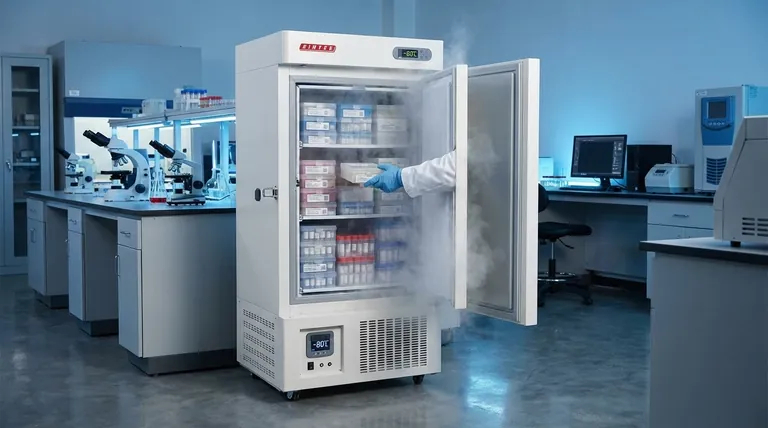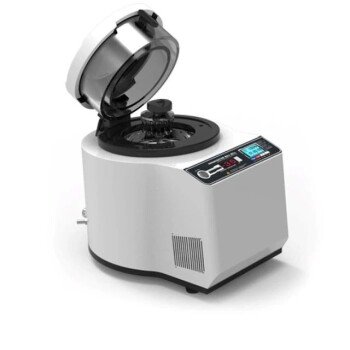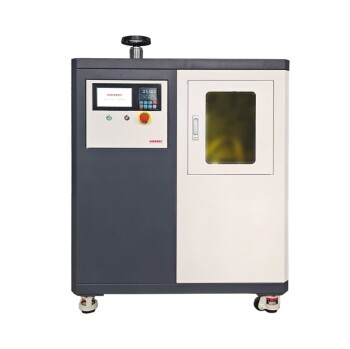At their core, ultra-low temperature (ULT) freezers are the bedrock of modern biological research. They create an environment of extreme cold, typically -80°C, which effectively pauses biological time. This halts the molecular and enzymatic activity that would otherwise degrade sensitive samples like DNA, RNA, proteins, and cell lines, ensuring their integrity is preserved for years or even decades.
The fundamental benefit of a ULT freezer is not merely cold storage; it is the preservation of scientific validity. By preventing sample degradation, these freezers ensure that research conducted today and in the future is based on consistent, viable, and uncompromised biological material.

The Core Function: Halting Biological Decay
The primary role of a ULT freezer is to create a stable environment that stops the natural process of sample breakdown. This capability is foundational to reliable and reproducible science.
Why Ultra-Low Temperatures Matter
Biological samples are in a constant state of change at room temperature. At -80°C, the kinetic energy of molecules is drastically reduced, effectively stopping the enzymatic reactions that cause molecules like RNA and proteins to degrade.
Ensuring Sample Integrity
Sample integrity means the sample accurately reflects its original biological state. By preventing degradation, ULT freezers ensure that when a researcher analyzes a sample, the results are trustworthy and not an artifact of poor storage.
Enabling Long-Term and Future Studies
ULT freezers allow researchers to create invaluable biobanks. Samples from a long-term study or a clinical trial can be stored and analyzed years later, providing a consistent source of material for follow-up experiments or the application of new research techniques.
Key Applications Across Research Fields
The need for reliable long-term storage makes ULT freezers indispensable across virtually every discipline of life science.
Genetics and Molecular Biology
These fields rely on the precise analysis of nucleic acids and proteins. ULT freezers are crucial for storing fragile RNA, genomic DNA, and complex protein structures without compromising their integrity.
Pharmaceutical and Drug Discovery
The development of vaccines and therapeutic drugs requires the stable storage of drug compounds, reagents, enzymes, and cell cultures. ULT storage ensures these components remain potent and consistent throughout the lengthy research and development process.
Medical and Clinical Research
Clinical samples, such as plasma, tissues, viruses, and bone material, are often irreplaceable. ULT freezers are used to archive these specimens for disease research, diagnostic development, and future patient care.
The Technology That Underpins Reliability
Modern ULT freezers are not simple appliances; they are sophisticated instruments engineered for precision, security, and efficiency.
Precision Temperature Control
Microprocessor-controlled systems constantly monitor and maintain the set temperature with extreme accuracy. Digital displays provide real-time feedback on cabinet, set, and even ambient temperatures, ensuring conditions are always optimal.
Critical Safety and Alarm Systems
To protect priceless samples, these freezers are equipped with robust alarm systems. They provide immediate notifications for temperature fluctuations, power failures, or sensor errors, allowing personnel to intervene before samples are compromised. Many high-end models feature dual cooling systems for built-in redundancy.
Efficient and Organized Storage
A standard ULT freezer can hold hundreds of storage boxes, each containing dozens of individual polymer tubes. This high-density, grid-based system allows for the meticulous organization and tracking of thousands of individual samples.
Understanding Modern Advancements and Considerations
While essential, traditional ULT freezers are known for being energy-intensive. This has driven significant innovation in their design and operation.
A Focus on Energy Efficiency
Modern units feature advanced insulation, high-efficiency compressors, and energy-saving "ECO modes" that reduce power consumption without sacrificing performance. Some next-generation models even use alternative technologies, like liquid nitrogen systems, to cut energy use dramatically.
Improving the Lab Environment
Manufacturers have also focused on the user experience. Innovations in compressor and fan design have led to significantly reduced noise levels, creating a more pleasant and productive work environment.
Data Management and Traceability
Many contemporary ULT freezers include USB ports for easy data logging. This allows for the simple download of temperature history, which is critical for quality control and regulatory compliance in many research settings.
Making the Right Choice for Your Goal
Selecting the appropriate ULT freezer depends entirely on the nature and value of the samples being stored.
- If your primary focus is irreplaceable samples (e.g., clinical trial specimens, rare cell lines): Prioritize models with dual, independent cooling systems and comprehensive alarm notifications for maximum security.
- If your primary focus is a large sample archive or biobank: Emphasize maximum storage capacity and compatibility with efficient inventory management and racking systems.
- If your primary focus is managing operational budgets and sustainability: Focus on newer, Energy Star-rated models with features like ECO modes or innovative insulation to minimize long-term electricity costs.
Ultimately, a ULT freezer is a direct investment in the certainty and future potential of your research.
Summary Table:
| Benefit | Key Function | Impact on Research |
|---|---|---|
| Sample Integrity | Halts enzymatic degradation | Ensures reliable, reproducible results |
| Long-Term Storage | Preserves samples for years/decades | Enables biobanking and future studies |
| Precision Control | Maintains stable -80°C environment | Protects sensitive biological materials |
| Safety & Security | Advanced alarm systems and redundancy | Safeguards irreplaceable research samples |
Secure the future of your research with KINTEK's reliable ULT freezers.
Your biological samples are the foundation of your work. Protect your valuable DNA, RNA, proteins, and cell lines with our precision-controlled, energy-efficient ultra-low temperature freezers. KINTEK specializes in lab equipment and consumables, serving laboratory needs with solutions designed for sample integrity and long-term viability.
Contact us today to find the perfect ULT freezer for your laboratory's specific requirements and ensure your research remains uncompromised.
Visual Guide

Related Products
- 108L Vertical Ultra Low Temperature ULT Freezer
- 938L Vertical Ultra Low Temperature Freezer for Advanced Laboratory Storage
- 158L Precision Vertical Ultra Low Freezer for Laboratory Applications
- 308L Precision Ultra Low Temperature Freezer for Laboratory Applications
- 608L Essential Laboratory Ultra Low Temperature Freezer For Critical Sample Preservation
People Also Ask
- How do Ultra-Low Temperature freezers ensure the integrity of microbiological samples? Maintain Stability for Critical Research
- What are ultra low temperature freezers used for? Preserving Critical Biological Samples for Decades
- What factors should be considered when selecting an ultra-low temperature freezer? Ensure Sample Integrity and Long-Term Value
- What are the common designs of ultra-low temperature freezers? Upright vs. Chest Models for Your Lab
- What advantages do ultra-low temperature freezers offer? Ensure Long-Term Sample Integrity and Reliability



















